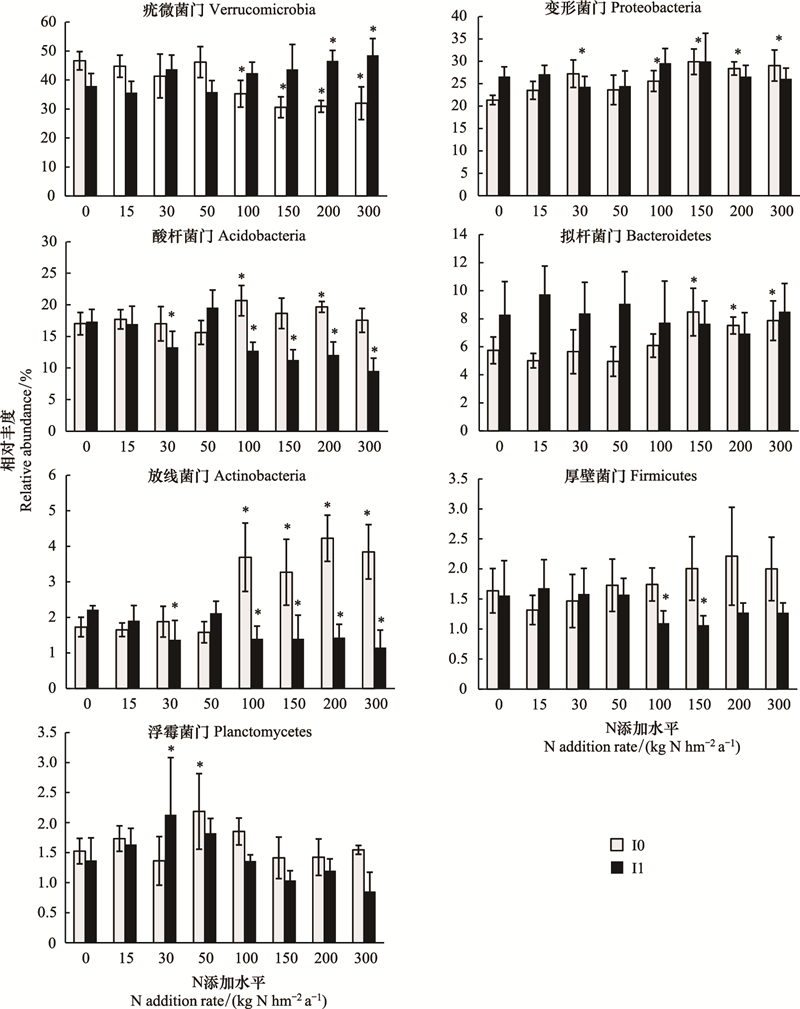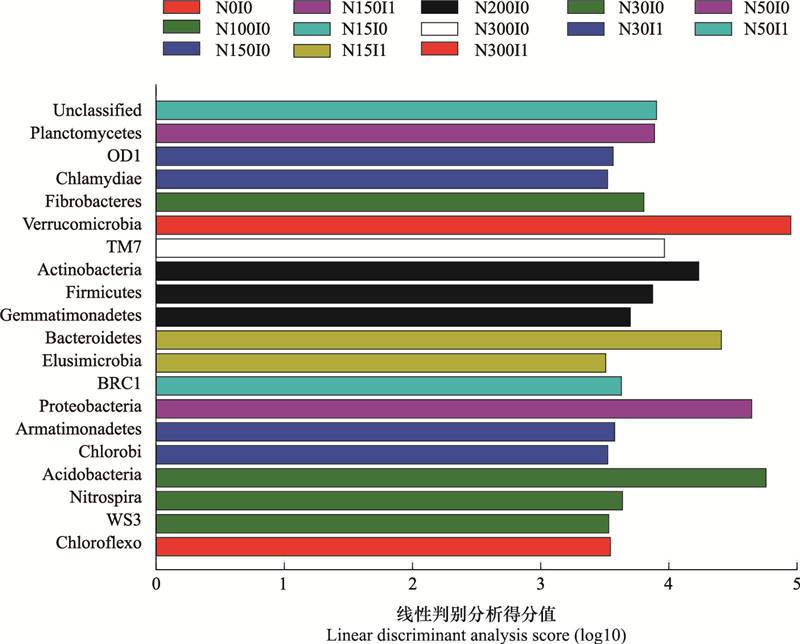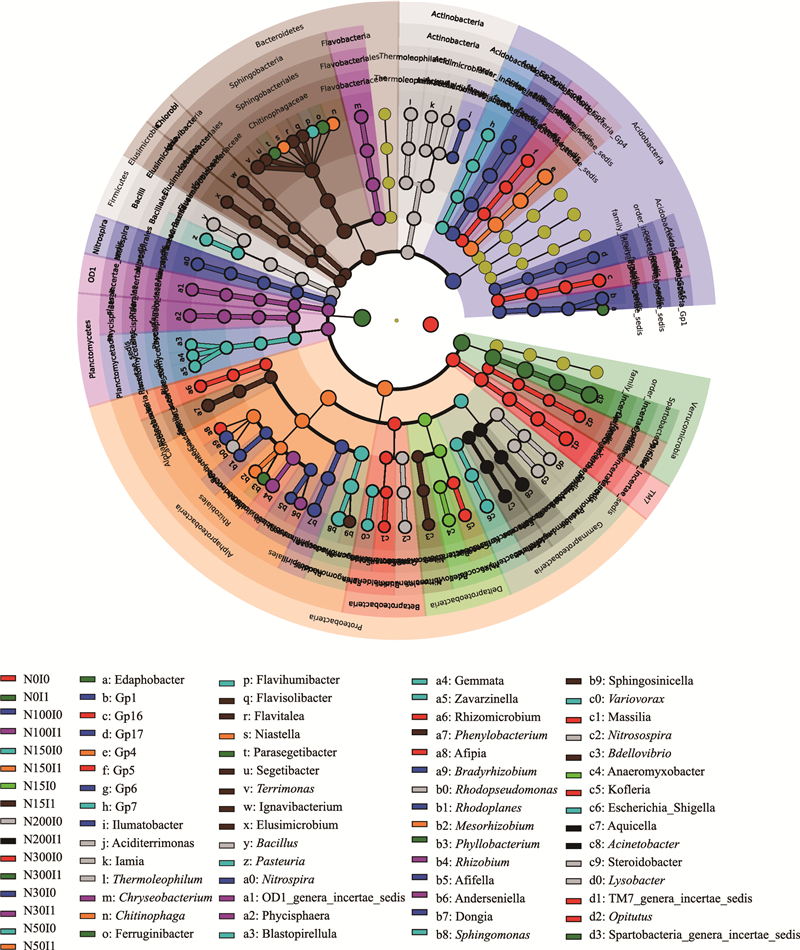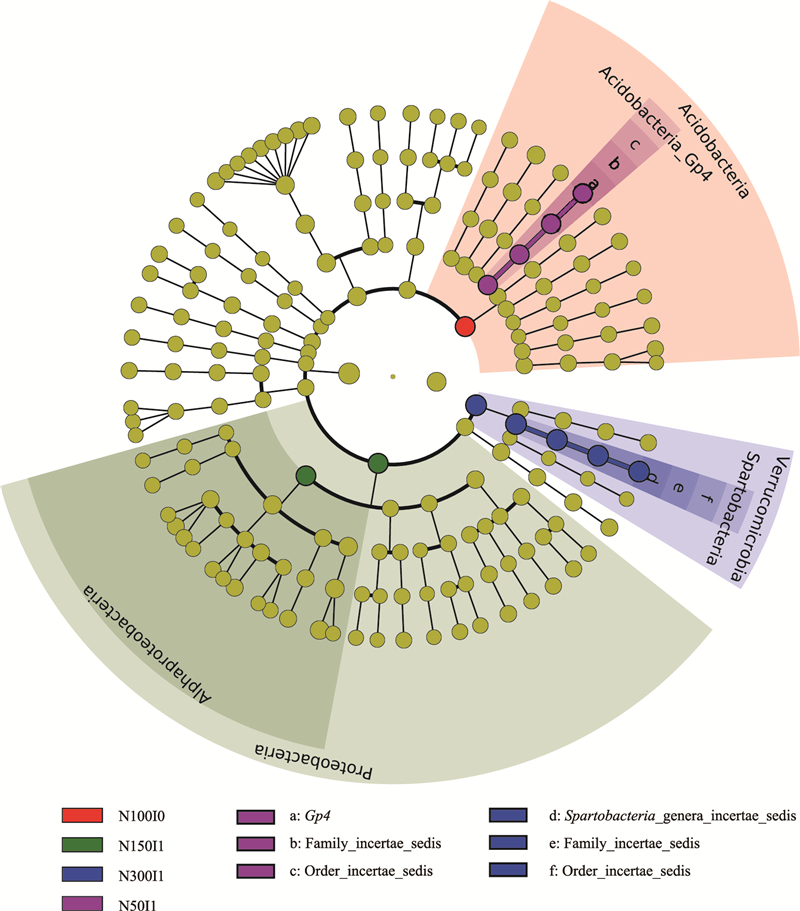文章信息
- 张海芳, 刘红梅, 赵建宁, 李刚, 赖欣, 李洁, 王慧, 杨殿林.
- ZHANG Haifang, LIU Hongmei, ZHAO Jianning, LI Gang, LAI Xin, LI Jie, WANG Hui, YANG Dianlin.
- 模拟氮沉降和降雨变化对贝加尔针茅草原土壤细菌群落结构的影响
- Effects of simulated nitrogen deposition and precipitation change on soil bacterial community structure in a Stipa baicalensis steppe
- 生态学报. 2018, 38(1): 244-253
- Acta Ecologica Sinica. 2018, 38(1): 244-253
- http://dx.doi.org/10.5846/stxb201612092539
-
文章历史
- 收稿日期: 2016-12-09
- 网络出版日期: 2017-09-12
由于化石燃料的燃烧以及农业施肥, 氮沉降明显增加, 对人类健康和环境产生负面影响[1]。大气氮沉降增加后, 土壤中氮素增加, 土壤原有的氮磷平衡改变[2], 土壤微生物量碳氮含量增加[3], 土壤细菌/真菌升高[4], 改变土壤微生物群落结构组成及功能特性[5]。土壤微生物在全球生物地球化学循环中起重要作用。土壤微生物多样性及其变化作为生态系统功能的敏感指标, 能够较早地指示土壤生态环境变化和生态系统功能的变化。
全球降水变化是气候变化最重要的现象之一。人类活动导致的全球变暖使水分循环加剧, 同时大气环流模式的变化导致暴风雨和亚热带干燥区域向两极迁移[6], 降水变化直接影响土壤含水量, 并决定提供给植物和微生物的水分可利用性[7]。土壤微生物群落对氮的响应很大程度上取决于水分状况[8]。已有大量研究报道了氮添加对草地生态系统植物和土壤微生物群落的影响[4, 9-10], 而氮素和水分在土壤微生物群落变化中的互作效应尚未完全探明。
贝加尔针茅草原是亚洲草原中心地带的典型代表, 在我国畜牧业生产中占有重要地位。本文通过模拟氮沉降和降雨增加试验, 研究贝加尔针茅草原土壤细菌群落结构的变化, 以期为将来预测多个气候因子交互作用对土壤微生物群落的影响提供依据, 同时为贝加尔针茅草原草地生态系统的可持续发展及建立草原土壤质量评价的微生物学指标体系提供理论依据。
1 材料与方法 1.1 试验区域概况及试验设计试验区域概况及试验设计方法参照本课题组已发表论文[11-12]。试验样地位于内蒙古呼伦贝尔市贝加尔针茅草原(119°42′E, 48°30′N)。样地区域海拔高度为760—770 m,年均降雨量约为329 mm。研究区域优势植物种类为贝加尔针茅(Stipa baicalensis)和羊草(Leymus chinensis)。土壤类型为栗钙土。试验采用裂区设计,于2010年开始布设试验样地,主区为灌溉处理,副区为施氮处理。灌溉设2个水平,分别为不灌溉和模拟夏季增雨100 mm灌溉。施氮设8个水平依次为: 0(CK)、15、30、50、100、150、200、300 kg N hm-2a-1(不包括大气沉降的氮量)。氮肥选用NH4NO3,将其溶解在8 L水中后均匀喷洒于各小区内。试验共16个处理,6次重复,小区面积8 m×8 m。
1.2 土壤样品采集土壤样品采集于2013年8月进行,使用直径为3 cm的土钻采集土样,采样深度为0—20 cm,在每个试验小区内设置10个采样点,将采集的土样混合均匀,去除动植物残体和大的石块后过2 mm筛,采用四分法选取1 kg新鲜土样,迅速装入无菌塑封袋,并尽快带回实验室,冻存于-20℃冰箱备用。
1.3 土壤DNA提取及PCR扩增采用E.Z.N.A. Soil DNA Kit (OMEGA)试剂盒提取土壤总DNA,方法参照说明书。每个土壤样品设3个平行提取,并分别进行PCR扩增反应。高通量测序前,将所得到的3个平行的PCR产物混合后进行测序[13]。基因组DNA的精确定量采用Qubit2.0 DNA试剂盒进行,以此确定PCR扩增时应加入的DNA量。PCR文库构建采用修改后的引物341f (5′-CCTACACGACGCTCTTCCGATCTN (barcode) CCTACGGGNGGCWGCAG-3′)和805r (5-GACTGGAGTTCCTTGGCACCCGAGAATTCCAGACTACHVGGGTATCTAATCC-3)[14],barcode长度为7 bp。PCR反应体系如下:10×PCR buffer 5μL,dNTP(10 mmol/L each) 0.5μL,Genomic DNA 10 ng,Bar-PCR引物F (50 μmol/L) 1μL,引物R (50 μmol/L) 1μL,PlantiumTaq酶(5U/μL) 0.5μL,加超纯水至50μL。反应条件如下:94°30s预变性,94°20s,45°20s,65°60s进行5个循环,94°20s,60°20s,72°20s进行20个循环,最后72°延长5min。PCR结束后,将PCR产物进行琼脂糖凝胶电泳,DNA回收采用上海生工琼脂糖回收试剂盒(cat:SK8131),之后用通用引物延伸扩增5个循环,条件如下:94°2min预变性,然后94°20s,60°20s,72°30s进行5个循环,最后72°延长5 min。
1.4 测序高通量测序采用Illumina Miseq平台,测序工作由生工生物工程(上海)股份有限公司完成。
1.5 数据处理和统计分析采用软件Prinseq (PRINSEQ-lite 0.19.5)和Flash (FLASH v1.2.7)对序列数据进行质量控制。去除非细菌序列,使用NAST将序列与Greengenes进行比对[15-16],然后进行RDP分类[17]。
采用Excel2007对数据进行整理,土壤细菌群落结构的差异采用在线软件Galaxy(https://huttenhower.sph.harvard.edu/galaxy)的LEfSe功能(Linear discriminant analysis (LDA) effect size)进行。LDA score 2.0表示差异显著,4.5表示差异极显著。采用SAS 9.2 (SAS Institute Inc., Cary, NC, USA)的裂区设计方差分析法分析氮素和水分的互作效应。
2 结果与分析 2.1 土壤细菌群落组成及丰度氮素和水分添加后, 在群落中占主导的细菌门类有疣微菌门Verrucomicrobia(30.61%—48.51%), 变形菌门Proteobacteria(21.37%—29.97%), 酸杆菌门Acidobacteria(9.54%—20.67%)和拟杆菌门Bacteroidetes(4.96%—9.74%)。在常规降雨和水分添加两种条件下, 随着氮添加水平的增加, 占主导的细菌门类(相对丰度>1%)表现出不同的变化趋势(图 1)。与常规降雨相比, 水分添加使优势细菌门类相对丰度呈现出完全不同的变化趋势。疣微菌门相对丰度在常规降雨N100—N300条件下显著降低, 但在氮素和水分同时添加条件下随氮添加水平升高而逐渐升高, 在N200—N300时显著升高。变形菌门和拟杆菌门相对丰度在常规降雨高氮添加条件下呈升高趋势, 但在水分添加时却无明显变化。酸杆菌门相对丰度在常规降雨高氮添加条件下升高, 但在水分添加后呈明显下降趋势。放线菌门Actinobacteria相对丰度在常规降雨N100—N300条件下显著升高, 但在水分添加后高氮添加时显著降低。厚壁菌门Firmicutes相对丰度在常规降雨条件下无显著变化, 但在水分和高氮添加条件下降低。浮霉菌门Planctomycetes相对丰度在两种不同的水分添加条件下均呈先升高后降低的趋势。由表 1可知, 氮素和水分添加对土壤细菌群落结构的变化存在明显的互作效应(P<0.0001)。

|
| 图 1 氮素和水分添加对土壤细菌不同门类相对丰度的影响 Fig. 1 Effects of N and water input on the relative abundance of soil bacterial phylum I0:氮添加, N addition;I1:施氮+灌溉, N addition +Irrigation;*表示差异显著(P<0.05) |
| 处理 Treatments |
自由度 df |
均方 Mean Square |
F | P |
| I | 1 | 0.005 | 3.96 | 0.050 |
| N | 7 | 0.002 | 1.19 | 0.318 |
| N×I | 7 | 0.029 | 21.45 | <0.0001 |
| N:氮添加, N addition;I:灌溉, Irrigation;N×I:施氮+灌溉, N addition +Irrigation | ||||
图 2显示了在不同处理中有显著差异的细菌门类。由图可知, 在不同氮素和水分添加条件下共有19个土壤细菌门类相对丰度变化显著, 差异最显著的前3个细菌门类分别为优势门类疣微菌门、酸杆菌门和变形菌门。其中, 疣微菌门相对丰度在N300I1处理中显著高于其他处理, 酸杆菌门相对丰度在N100I0处理中显著高于其他处理, 变形菌门相对丰度在N150I1处理中显著高于其他处理。

|
| 图 2 不同处理土壤细菌群落差异的LEfSe分析 Fig. 2 The results of LEfSeanalysis for soil bacterial community under different treatments Unclassified:未分类细菌;Planctomycetes:浮霉菌门;Chlamydiae:衣原体门;Fibrobacteres:纤维杆菌门;Verrucomicrobia:疣微菌门;Actinobacteria:放线菌门;Firmicutes:厚壁菌门;Gemmatimonadetes:芽单胞菌门;Bacteroidetes:拟杆菌门;Elusimicrobia:迷踪菌门;Proteobacteria:变形菌门;Armatimonadetes:装甲菌门;Chlorobi:绿菌门;Acidobacteria:酸杆菌门;Nitrospira:硝化螺旋菌门;Chloroflexi:绿弯菌门 |
挑选在所有处理中平均相对丰度大于0.1的属进行分析, 共66个属, 相对丰度总和占土壤细菌群落的93.9%。图 3显示了不同处理土壤细菌群落系统进化树, 黄色表示丰度没有显著差异, 有显著差异的种类根据处理进行着色, 圆圈直径大小表示相对丰度大小。由图可知, 有显著差异的属共61个, 相对丰度最高的为疣微菌门。图 4显示了相对丰度有极显著差异的属, 分别是疣微菌门的Spartobacteria属和酸杆菌门的Gp4属。这说明氮素和水分添加后, 土壤细菌群落结构的变化主要与疣微菌门和酸杆菌门的变化有关。

|
| 图 3 不同处理土壤细菌群落系统发育树(LDA阈值2.0) Fig. 3 The cladogram of soil bacterial community under different treatments (LDA score=2.0) Thermoleophilum:嗜油菌属;Chryseobacterium:金黄杆菌属;Chitinophaga:噬几丁质菌属;Terrimonas:发菌属;Bacillus:芽孢杆菌属;Pasteuria:巴斯德氏菌属;Nitrospira:硝化螺旋菌属;Phenylobacterium:苯基杆菌属;Bradyrhizobium:慢生根瘤菌属;Rhodopseudomonas:红假单胞菌属;Rhodoplanes:红游动菌属;Mesorhizobium:中慢生根瘤菌属;Phyllobacterium:叶杆菌属;Rhizobium:根瘤菌属;Sphingomonas:鞘脂单胞菌属;Variovorax:贪食菌属;Nitrosospira:亚硝化螺菌属;Bdellovibrio:蛭弧菌属;Acinetobacter:不动杆菌属;Lysobacter:溶杆菌属;Opitutus:丰佑菌属 |

|
| 图 4 不同处理土壤细菌群落系统发育树(LDA阈值4.5) Fig. 4 The cladogram of soil bacterial community under different treatments (LDA score=4.5) Acidobacteria:酸杆菌门;Verrucomicrobia:疣微菌门;Proteobacteria:变形菌门;Alphaproteobacteria:α变形菌纲;family-incertae-sedis:科-分类地位未定;order-incertae-sedis:目-分类地位未定;Spartobacteria-genera-incertae-sedis:属名-分类地位未定;Gp4:细菌的一个属名 |
在草地生态系统中, 氮素作为一种限制因子, 适量输入可以为植物生长提供营养, 但过量输入则可能对生态系统造成负面影响[17-19]。在常规降雨和水分添加两种条件下, 随着氮添加水平的增加, 不同的细菌门类相对丰度表现出不同的变化趋势。其他研究也得到了类似的结果。Cederlund等[20]研究表明氮肥是土壤细菌相对丰度变化最重要的驱动因子。氮沉降降低了整个细菌群落的多样性并改变了群落组成[21], 导致特定细菌门类的相对丰度发生改变[22]。这可能主要是因为氮输入增加后土壤硝态氮含量升高导致土壤pH降低[23]并改变土壤C:N:P化学计量比[24], 进而对地上和地下群落造成负面影响, 改变土壤微生物群落结构及生物量[25]。土壤酸化改变土壤细菌群落的机制主要包括酸化对细菌群落的生态选择和土壤细菌群落在酸化环境压力下的适应性进化两方面[26]。陈哲等[27]研究也表明长期施氮对土壤细菌群落结构产生了明显的影响。袁红朝等[28-29]研究也发现长期施肥对土壤细菌及固碳细菌群落结构, 多样性及数量均有显著的影响。
降水变化直接影响土壤含水量, 降雨量和降雨的季节性变化决定了提供给植物和微生物的水分可利用性[7]。与常规降雨条件相比, 水分添加使土壤细菌门类呈现出不同的变化趋势, 如疣微菌门相对丰度在常规降雨条件下随氮添加水平升高逐渐降低, 但在氮素和水分同时添加条件下随氮添加水平升高而逐渐升高。这说明水分在氮素作用的发挥中至关重要, 氮素和水分对土壤细菌群落的变化存在明显的互作效应。这可能是因为水分添加导致土壤中溶解态的硝态氮含量增加, 进一步降低了土壤pH[11], 从而改变了土壤细菌群落结构。Zhang等[30]研究也发现降雨增加可改变氮添加对土壤微生物群落的影响, 当水分充足时, 氮添加对土壤微生物存在正面效应。杨山等[31]采用PCR-DGGE的方法对北方草地的研究也表明氮添加和增雨明显改变了土壤细菌群落结构。王宁等[32]在森林生态系统中的研究也表明降水变化使土壤微生物群落结构和组成发生了改变。在多个气候变化因子共同作用条件下, 土壤微生物群落的种群消长、群落演替特征表现出与单个因子作用时不同的复杂变化, 因此在以后的研究中, 探讨多个气候变化因素对生态系统的互作效应更为重要。
LEfSe分析以不同细菌门类的相对丰度为数据基础, 可以找出不同处理间有显著差异的门类, 即可指示不同处理间显著差异的变化指示种。在LDA得分4.5的极显著差异水平下, 疣微菌门和酸杆菌门相对丰度变化显著。这说明在不同的氮素和水分添加水平下, 疣微菌门和酸杆菌门可作为土壤细菌群落结构变化的指示种。Keiblinger等[33]研究也指出疣微菌门对氮添加的响应敏感, 其相对丰度与土壤氮含量存在负相关关系[20, 34]。也有研究表明酸杆菌门相对丰度与土壤N含量和pH呈典型负相关[22, 35-36]。而变形菌门属需营养类群, 其相对丰度在高氮水平下通常增加[37-38]。此外, 放线菌门相对丰度在氮素和水分同时添加条件下无明显变化, 有研究显示放线菌门相对丰度的变化与土壤碳氮含量并无特定的线性关系[39]。但在本研究中, 常规降雨条件下放线菌门相对丰度与氮添加水平显著相关, 这可能主要与其自身在不同水分条件下的形态特征有关。这说明放线菌门对氮素添加的响应依不同的水分状况存在差异。
4 结论氮素和水分添加改变了土壤细菌群落结构, 且氮素和水分存在明显的互作效应。水分添加可改变氮添加对土壤细菌群落结构的影响。疣微菌门和酸杆菌门可作为土壤细菌群落结构变化的指示种。这说明随着未来氮沉降和降水变化加剧, 将对土壤细菌群落结构产生重要的影响。氮沉降和降水变化是一个长期渐进的过程, 仍存在诸多不确定性,其对草地生态系统各组分影响的累积效应仍需进行长期监测研究。
| [1] | Liu X J, Zhang Y, Han W X, Tang A H, Shen J L, Cui Z L, Vitousek P, Erisman J W, Goulding K, Christie P, Fangmeier A, Zhang F S. Enhanced nitrogen deposition over China. Nature, 2013, 494(7438): 459–462. DOI:10.1038/nature11917 |
| [2] | Peñuelas J, Poulter B, Sardans J, Ciais P, van der Velde M, Bopp L, Boucher O, Godderis Y, Hinsinger P, Llusia J, Nardin E, Vicca S, Obersteiner M, Janssens I A. Human-induced nitrogen-phosphorus imbalances alter natural and managed ecosystems across the globe. Nature Communications, 2013, 4: 2934. |
| [3] | 臧逸飞, 郝明德, 张丽琼, 张昊青. 26年长期施肥对土壤微生物量碳、氮及土壤呼吸的影响. 生态学报, 2015, 35(5): 1445–1451. |
| [4] | 施瑶, 王忠强, 张心昱, 孙晓敏, 刘希玉, 何念鹏, 庾强. 氮磷添加对内蒙古温带典型草原土壤微生物群落结构的影响. 生态学报, 2014, 34(17): 4943–4949. |
| [5] | Leff J W, Jones S E, Prober S M, Barberán A, Borer E T, Firn J L, Harpole W S, Hobbie S E, Hofmockel K S, Knops J M H, McCulley R L, La Pierre K, Risch A C, Seabloom E W, Schüetz M, Steenbock C, Stevens C J, Fierer N. Consistent responses of soil microbial communities to elevated nutrient inputs in grasslands across the globe. Proceedings of the National Academy of Sciences of the United States of America, 2015, 112(35): 10967–10972. DOI:10.1073/pnas.1508382112 |
| [6] | Marvel K, Bonfils C. Identifying external influences on global precipitation. Proceedings of the National Academy of Sciences of the United States of America, 2013, 110(48): 19301–19306. DOI:10.1073/pnas.1314382110 |
| [7] | Sorensen P O, Germino M J, Feris K P. Microbial community responses to 17 years of altered precipitation are seasonally dependent and coupled to co-varying effects of water content on vegetation and soil C. Soil Biology and Biochemistry, 2013, 64: 155–163. DOI:10.1016/j.soilbio.2013.04.014 |
| [8] | Bi J, Zhang N L, Liang Y, Yang H J, Ma K P. Interactive effects of water and nitrogen addition on soil microbial communities in a semiarid steppe. Journal of Plant Ecology, 2012, 5(3): 320–329. DOI:10.1093/jpe/rtr046 |
| [9] | Yu C, Hu X M, Deng W, Li Y, Xiong C, Ye C H, Han G M, Li X. Changes in soil microbial community structure and functional diversity in the rhizosphere surrounding mulberry subjected to long-term fertilization. Applied Soil Ecology, 2015, 86: 30–40. DOI:10.1016/j.apsoil.2014.09.013 |
| [10] | Ma H K, Bai G Y, Sun Y, Kostenko O, Zhu X, Lin S, Ruan W B, Zhao N X, Bezemer T M. Opposing effects of nitrogen and water addition on soil bacterial and fungal communities in the Inner Mongolia steppe:a field experiment. Applied Soil Ecology, 2016, 108: 128–135. DOI:10.1016/j.apsoil.2016.08.008 |
| [11] | 王杰, 李刚, 修伟明, 宋晓龙, 赵建宁, 杨殿林. 氮素和水分对贝加尔针茅草原土壤酶活性和微生物量碳氮的影响. 农业资源与环境学报, 2014, 31(3): 237–245. |
| [12] | 张海芳, 刘红梅, 赵建宁, 李刚, 赖欣, 李洁, 王慧, 杨殿林. 贝加尔针茅草原土壤真菌群落结构对氮素和水分添加的响应. 生态学报, 2018, 38(1): 195–205. |
| [13] | Mackelprang R, Waldrop M P, DeAngelis K M, David M M, Chavarria K L, Blazewicz S J, Rubin E M, Jansson J K. Metagenomic analysis of a permafrost microbial community reveals a rapid response to thaw. Nature, 2011, 480(7377): 368–371. DOI:10.1038/nature10576 |
| [14] | Herlemann D P R, Labrenz M, Jürgens K, Bertilsson S, Waniek J J, Andersson A F. Transitions in bacterial communities along the 2000 km salinity gradient of the Baltic Sea. The ISME Journal, 2011, 5(10): 1571–1579. DOI:10.1038/ismej.2011.41 |
| [15] | DeSantis G, Davis B G. The expanding roles of biocatalysis and biotransformation. Current Opinion in Chemical Biology, 2006, 10(2): 139–140. DOI:10.1016/j.cbpa.2006.02.037 |
| [16] | Caporaso J G, Bittinger K, Bushman F D, DeSantis T Z, Andersen G L, Knight R. PyNAST:a flexible tool for aligning sequences to a template alignment. Bioinformatics, 2010, 26(2): 266–267. DOI:10.1093/bioinformatics/btp636 |
| [17] | Cole J R, Chai B, Farris R J, Wang Q, Kulam S A, McGarrell D M, Garrity G M, Tiedje J M. The Ribosomal Database Project (RDP-Ⅱ):sequences and tools for high-throughput rRNA analysis. Nucleic Acids Research, 2005, 33(S1): D294–D296. |
| [18] | Stevens C J, Dise N B, Mountford J O, Gowing D J. Impact of nitrogen deposition on the species richness of grasslands. Science, 2004, 303(5665): 1876–1879. DOI:10.1126/science.1094678 |
| [19] | Roth T, Kohli L, Rihm B, Achermann B. Nitrogen deposition is negatively related to species richness and species composition of vascular plants and bryophytes in Swiss mountain grassland. Agriculture Ecosystems & Environment, 2013, 178: 121–126. |
| [20] | Cederlund H, Wessén E, Enwall K, Jones C M, Juhanson J, Pell M, Philippot L, Hallin S. Soil carbon quality and nitrogen fertilization structure bacterial communities with predictable responses of major bacterial phyla. Applied Soil Ecology, 2014, 84: 62–68. DOI:10.1016/j.apsoil.2014.06.003 |
| [21] | Freedman Z B, Romanowicz K J, Upchurch R A, Zak D R. Differential responses of total and active soil microbial communities to long-term experimental N deposition. Soil Biology and Biochemistry, 2015, 90: 275–282. DOI:10.1016/j.soilbio.2015.08.014 |
| [22] | Turlapati S A, Minocha R, Bhiravarasa P S, Tisa L S, Thomas W K, Minocha S C. Chronic N-amended soils exhibit an altered bacterial community structure in Harvard Forest, MA, USA. FEMS Microbiology Ecology, 2013, 83(2): 478–493. DOI:10.1111/1574-6941.12009 |
| [23] | Turner M M, Henry H A L. Interactive effects of warming and increased nitrogen deposition on 15N tracer retention in a temperate old field:seasonal trends. Global Change Biology, 2009, 15(12): 2885–2893. DOI:10.1111/gcb.2009.15.issue-12 |
| [24] | Elser J J, Andersen T, Baron J S, Bergström A K, Jansson M, Kyle M, Nydick K R, Steger L, Hessen D O. Shifts in lake N:P stoichiometry and nutrient limitation driven by atmospheric nitrogen deposition. Science, 2009, 326(5954): 835–837. DOI:10.1126/science.1176199 |
| [25] | Chen D M, Lan Z C, Hu S J, Bai Y F. Effects of nitrogen enrichment on belowground communities in grassland:relative role of soil nitrogen availability vs. soil acidification. Soil Biology and Biochemistry, 2015, 89: 99–108. DOI:10.1016/j.soilbio.2015.06.028 |
| [26] | Zhang X M, Liu W, Zhang G M, Jiang L, Han X G. Mechanisms of soil acidification reducing bacterial diversity. Soil Biology and Biochemistry, 2015, 81: 275–281. DOI:10.1016/j.soilbio.2014.11.004 |
| [27] | 陈哲, 陈春兰, 秦红灵, 王霞, 吴敏娜, 魏文学. 化肥对稻田土壤细菌多样性及硝化、反硝化功能菌组成的影响. 生态学报, 2009, 29(11): 6142–6147. DOI:10.3321/j.issn:1000-0933.2009.11.048 |
| [28] | 袁红朝, 秦红灵, 刘守龙, 童成立, 葛体达, 魏文学, 吴金水. 长期施肥对稻田土壤固碳功能菌群落结构和数量的影响. 生态学报, 2012, 32(1): 183–189. |
| [29] | 袁红朝, 吴昊, 葛体达, 李科林, 吴金水, 王久荣. 长期施肥对稻田土壤细菌、古菌多样性和群落结构的影响. 应用生态学报, 2015, 26(6): 1807–1813. |
| [30] | Zhang N L, Wan S Q, Guo J X, Han G D, Gutknecht J, Schmid B, Yu L, Liu W X, Bi J, Wang Z, Ma K P. Precipitation modifies the effects of warming and nitrogen addition on soil microbial communities in northern Chinese grasslands. Soil Biology and Biochemistry, 2015, 89: 12–23. DOI:10.1016/j.soilbio.2015.06.022 |
| [31] | 杨山, 李小彬, 王汝振, 蔡江平, 徐柱文, 张玉革, 李慧, 姜勇. 氮水添加对中国北方草原土壤细菌多样性和群落结构的影响. 应用生态学报, 2015, 26(3): 739–746. |
| [32] | 王宁, 王美菊, 李世兰, 王楠楠, 冯富娟, 韩士杰. 降水变化对红松阔叶林土壤微生物生物量生长季动态的影响. 应用生态学报, 2015, 26(5): 1297–1305. |
| [33] | Keiblinger K M, Hall E K, Wanek W, Szukics U, Häemmerle I, Ellersdorfer G, Böeck S, Strauss J, Sterflinger K, Richter A, Zechmeister-Boltenstern S. The effect of resource quantity and resource stoichiometry on microbial carbon-use-efficiency. FEMS Microbiology Ecology, 2010, 73(3): 430–440. |
| [34] | Ramirez K S, Craine J M, Fierer N. Consistent effects of nitrogen amendments on soil microbial communities and processes across biomes. Global Change Biology, 2012, 18(6): 1918–1927. DOI:10.1111/gcb.2012.18.issue-6 |
| [35] | Naether A, Foesel B U, Naegele V, Wüest P K, Weinert J, Bonkowski M, Alt F, Oelmann Y, Polle A, Lohaus G, Gockel S, Hemp A, Kalko E K V, Linsenmair K E, Pfeiffer S, Renner S, Schöening I, Weisser W W, Wells K, Fischer M, Overmann J, Friedrich M W. Environmental factors affect acidobacterial communities below the subgroup level in grassland and forest soils. Applied and Environmental Microbiology, 2012, 78(20): 7398–7406. DOI:10.1128/AEM.01325-12 |
| [36] | Zhou J, Guan D W, Zhou B K, Zhao B S, Ma M C, Qin J, Jiang X, Chen S F, Cao F M, Shen D L, Li J. Influence of 34-years of fertilization on bacterial communities in an intensively cultivated black soil in northeast China. Soil Biology and Biochemistry, 2015, 90: 42–51. DOI:10.1016/j.soilbio.2015.07.005 |
| [37] | Wessén E, Hallin S, Philippot L. Differential responses of bacterial and archaeal groups at high taxonomical ranks to soil management. Soil Biology and Biochemistry, 2010, 42(10): 1759–1765. DOI:10.1016/j.soilbio.2010.06.013 |
| [38] | Fierer N, Lauber C L, Ramirez K S, Zaneveld J, Bradford M A, Knight R. Comparative metagenomic, phylogenetic and physiological analyses of soil microbial communities across nitrogen gradients. TheISME Journal, 2012, 6(5): 1007–1017. |
| [39] | Cruz-Martínez K, Rosling A, Zhang Y, Song M Z, Andersen G L, Banfield J F. Effect of rainfall-induced soil geochemistry dynamics on grassland soil microbial communities. Applied and Environmental Microbiology, 2012, 78(21): 7587–7595. DOI:10.1128/AEM.00203-12 |
 2018, Vol. 38
2018, Vol. 38




